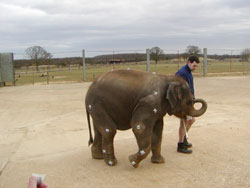Have you ever seen an elephant…… run?

A young elephant steps out at Whipsnade Wild Animal Park while cameras record the movement of the disc shaped markers on its legs and back.
Dr John Hutchinson, a research leader at the UK’s Royal Veterinary College (RVC), has already shown that, contrary to previous studies and most popular opinion, elephants moving at speed appear to be running. Now with funding from the Biotechnology and Biological Sciences Research Council (BBSRC) his team is using Hollywood-style motion capture cameras combined with MRI and CT scans of elephants to build 3D computer models of elephant locomotion to show the forces and stresses at work on muscles, tendons and bones.
The research team has been working with elephants at UK wildlife and safari parks and will shortly travel to Africa and Thailand to study wild animals. Fifteen temporary markers are placed on the elephants’ joints and the animals then move past a motion capture camera, recording at 240 frames per second, at varying speeds. Back in the lab the researchers can then use the footage to reconstruct the rotations of the elephants’ joints on a computer, creating a 3D stick model of the animal.
The computer models are being used to establish how limb structure relates to elephant locomotion and to determine finally if elephants really can run – or in scientific terms, at some point do they have all their feet off the ground at the same time? Dr Hutchinson said: “We are particularly interested how elephants coordinate their limbs and working out which joints contribute most to the length and frequency of their steps. In examining whether elephants truly run or not we need to understand what limits their top speed. Is it the tendons and muscles having to withstand the impact of 7 tonnes of elephant or is it something else?”
This is not a trivial question as Dr Hutchinson explained: “A better understanding of elephant biomechanics offers the possibility for real animal welfare improvements. By developing ways to spot slight changes in gait and joint movements in captive elephants we can catch the early onset of osteomyelitis and arthritis. If these conditions are not treated early they can result in an elephant being put down.”
The research also informs other biomechanical studies as the elephant leg has surprising similarities to our own. Humans have the same structure of a straight leg with a long thigh and short foot. Studies of animal locomotion are also key to the design of effective walking robots. By understanding how evolution achieved the joint structure and limb coordination of an animal as large as an elephant we will be better able to construct our own man-made walking robots.
Media Contact
More Information:
http://www.bbsrc.ac.ukAll latest news from the category: Life Sciences and Chemistry
Articles and reports from the Life Sciences and chemistry area deal with applied and basic research into modern biology, chemistry and human medicine.
Valuable information can be found on a range of life sciences fields including bacteriology, biochemistry, bionics, bioinformatics, biophysics, biotechnology, genetics, geobotany, human biology, marine biology, microbiology, molecular biology, cellular biology, zoology, bioinorganic chemistry, microchemistry and environmental chemistry.
Newest articles

Red light therapy for repairing spinal cord injury passes milestone
Patients with spinal cord injury (SCI) could benefit from a future treatment to repair nerve connections using red and near-infrared light. The method, invented by scientists at the University of…

Insect research is revolutionized by technology
New technologies can revolutionise insect research and environmental monitoring. By using DNA, images, sounds and flight patterns analysed by AI, it’s possible to gain new insights into the world of…

X-ray satellite XMM-newton sees ‘space clover’ in a new light
Astronomers have discovered enormous circular radio features of unknown origin around some galaxies. Now, new observations of one dubbed the Cloverleaf suggest it was created by clashing groups of galaxies….





















